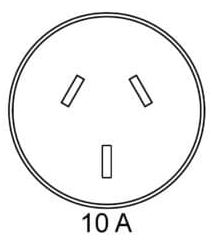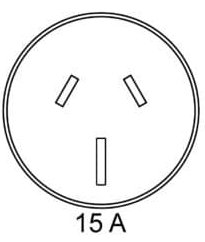News
ELECTRIC VEHICLE CHARGING STATIONS – PART TWO ‘KNOW THY PRODUCT’
February 17, 2023
Yes. I know. I promised this article earlier. I have a good excuse – merging my firm Stratum Legal with Bugden Allen Graham Lawyers, has taken just a teensy, weensy bit of my time….
On the upside, the delay means that the 2022 numbers are out, so we can check progress on the bet with my Dad. According to Drive.com.au electric vehicles sales have been rapidly increasing; 0.5% of total new car sales in 2021 and 3.1% in 2022. If you add in hybrids (including plug in hybrids) then 11.2% of all new cars sold in Australia, in 2022, ran partly on electricity. Only 39% to go!
Here is the most basic EV charger there is ….

Looks familiar, doesn’t it? That, ladies and gentlemen, is a standard, 240 volt, 10-amp, general purpose outlet.
If you are lucky, as an EV owner, you might have access to one of these:

That’s a standard, 240 volt, 15-amp, general purpose outlet.
Why lucky? Well to understand that, you need to understand a few basics about electricity. After all, we are talking about charging Electric Vehicles. So then if electricity is a ‘river’ of electrons:
- Amps – is the volume of electrons flowing past
- Volts – is the pressure of the flow
- Watts – is the work that the electrons can do, such as turning a water wheel
- Ohms – is the total of the forces resisting the flow, like rocks in the river
Watts are a function of Amps and Volts. Simply multiply one by the other and voila, you get Watts. A relevant acronym you may have seen is kWh, which is kilowatt hours. That is the number of Watts being used, or which could be used, to do work over an hour.
Let’s consider the most basic EV charging scenario – imagine you are ‘filling up’ the battery, in your second generation Nissan Leaf, which has a 40 kWh battery and a 110kW electric motor. Putting aside the ‘enemy’ (Ohms) and a few other basic laws of physics and electrical engineering, if we flogged that poor little Nissan Leaf, at full throttle, then we would get around about 22 minutes of drive time. i.e. 40kWh/110kW*60 minutes = 22 minutes approx.…
Fortunately, the real-world consumption rate is a lot less, and our friends at Nissan tell us that we can expect to get about 270klms out of that Leaf. Turning now to ‘filling’ the battery back up, by charging it, and again ignoring all of that other pesky, real-world stuff, a 10amp GPO, at 240v is going to deliver 2400 watts of power, or 2.4kW. As we need to put 40kWh ‘back in’ to the battery, that will only take us about … 16 hours to do. A 15amp GPO gives us 3.6kW, which cuts charge time to about 11 hours. Now while l like a sleep in as much as the next fella, my little Leaf is not going to charge in the time between when I arrive home of an evening and the next morning when I drag my sorry carcass back to work.
So, how do we solve this conundrum? The answer is a hell of a lot more electrons being pushed down the charging cable, with a lot more force; i.e. more Amps and / or more Volts. Our friends at Nissan recommend that I see Jet Charge, so they can supply me with a dedicated wall charger for my Leaf. About the size of 3 reams of copy paper, the charger sits on the wall and pumps out 6.6kW, resulting in a full charge in about 6 hours.
Having the patience of a gnat however, I start googling and discover… DC fast chargers, available in 50kW or 100kW options, which will charge my battery in 1 hour! Fantastic I say… but ‘can the wiring in my unit handle all that juice?’
And that, ladies and gentlemen is the rub. My ‘normal’ 10amp GPO circuit, has a 16amp residual current breaker, with overcurrent protection, and cuts out at 3.84kW. My wall charger is going to take two, ‘normal’ power circuits, for 7 hours at a time. After poking about in my meter box, I see that my main ‘breaker’ is rated to 100Amps. That’s the most power that I can use, in my entire unit, at any point in time. Ignoring the AC / DC issue, at 240 volts, 100 amps is going to give me 24kW max. Where do I get the extra kW’s for my DC fast charger? Well, Fred in Unit 12 next door is never home, so I might use some of his power… I’ll pay him for it of course.
Now that, is a very basic summary of the three, widely accepted, categories or standards for EV charging that we currently have, which RACQ has summarised simply and elegantly on its website:
- Level 1 – you plug in into a 10amp GPO using your Electric Vehicle Supply Equipment (EVSE).
- Level 2 – you plug into a wall box charger, which is connected to a ‘standard’ power supply.
- Level 3 – you plug into a dedicated high-power EV charging station (DC).
As for how you ‘plug in’, including the format of the plugs, well that info probably has the same useful shelf life as a copy of ‘Big Trouble in Little China’, on BetaMax video tape. We don’t know yet who will win the VHS v BetaMax style war, between Type 2, CHAdeMO and Tesla connectors. Suffice to say that (no doubt) they all do a very good and safe job of bridging the gap between electricity supply and car, with various pit stops along the way, including the electronics which deliver the river of electrons in a beautiful, uniform and useful stream.
You will note that I have (just then) completely passed over the fascinating topic of how the chargers do their thing, with all sorts of clever circuits and cleverer programming, resulting in a rejuvenating charge, that massages your battery, soothes away all its cares and reduces wrinkles…. In fairness, that stuff can actually make a difference in strata installations. As such, I will talk about it in my next article, because it’s relevant to how bodies corporate can make themselves ready for lot owner requests to approve EV charger installations. As a teaser, consider this. Level 1 charging (normally) involves nothing more or less than a lot owner putting in an extra power point, wherever that may be required. Level 2 requires a ‘box on the wall’ and (usually) the equivalent of ‘2 power points’ worth of wiring to the box (yes, I know, all of you electricians and electrical engineers out there will crucify me, so just don’t start!). Level 3 on the other hand, crosses a line – the lot owner needs power from another lot, or the common property….
This article was contributed by Michael Kleinschmidt, Stratum Legal.
The post ELECTRIC VEHICLE CHARGING STATIONS – PART TWO ‘KNOW THY PRODUCT’ appeared first on Smart Strata | Body Corporate Management.
